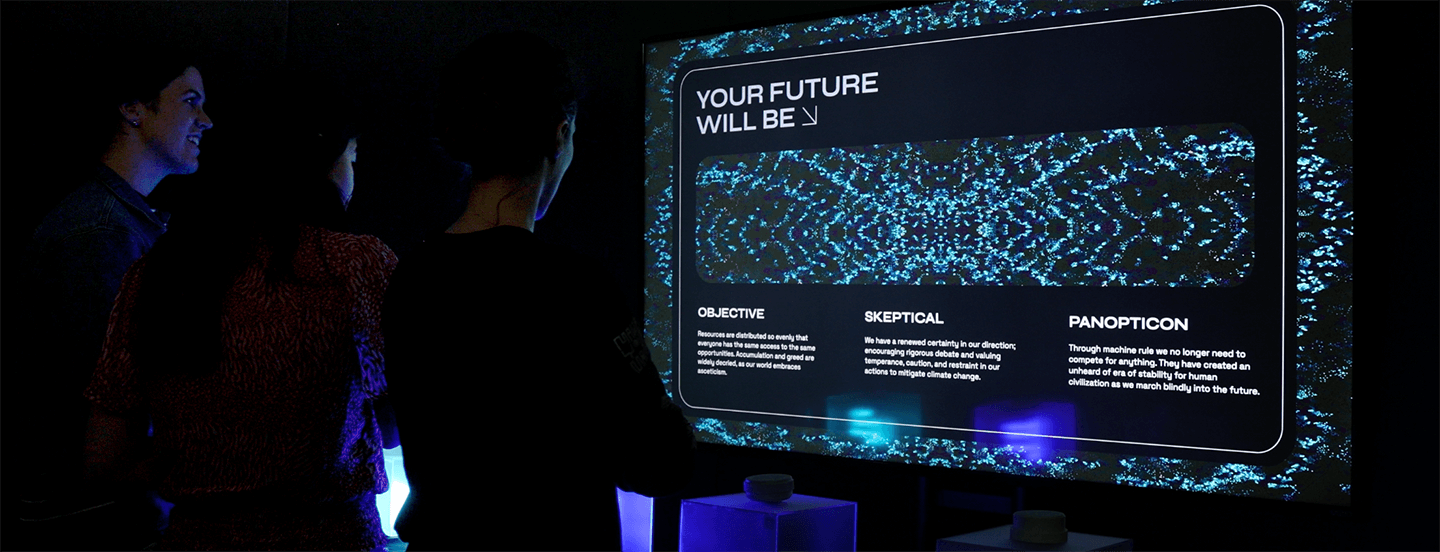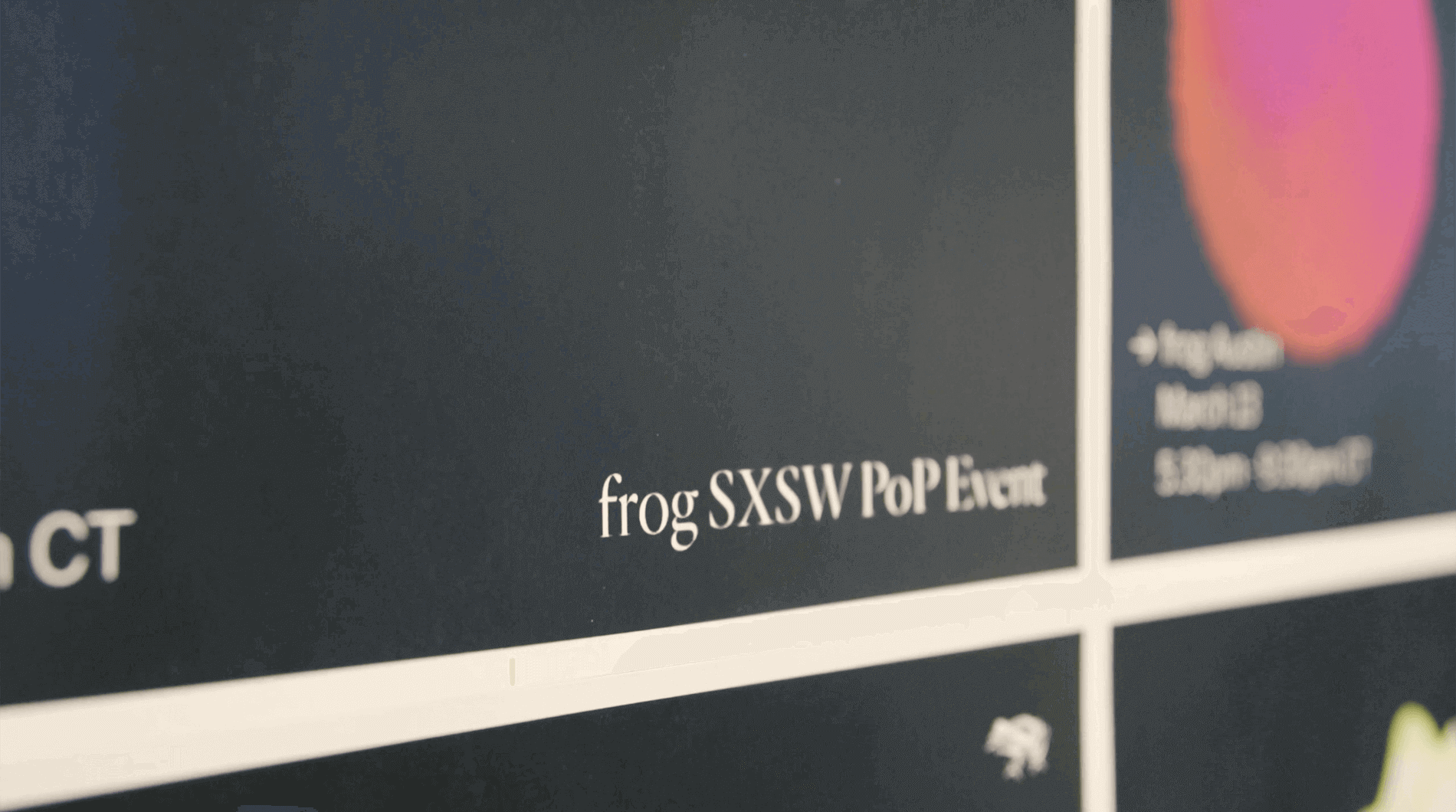
The Room of Silence: Experience Then Act
Considering 55% of communication is nonverbal, how does one communicate nonverbally?
At this year’s SXSW Festival, frog explored this question and others in a series of on-site “provocation rooms.” Each room focused on power of provocation to stimulate thought.
Esteemed body language researcher Dr. Albert Mehrabian found that communication is 55% nonverbal, 38% vocal and 7% words only. This science supported formation of The Room of Silence, which prompted people to question their existing modes of communication and beliefs about the world and use body language and movement to imagine their ideal future, linking physical actions to individual actions they might take to shape it.
Silent Interactions: The Powerful Implications of Nonverbal Tech
Inside The Room of Silence, frogs digitized communication, translating it from action to visuals to reaction. According to frog alum Alexander Kennedy, “We used sensors and technology in ways that prompted thinking around how technology can communicate with you nonverbally and how you can communicate with technology nonverbally.” The premise behind The Room of Silence was to generate change through action, to encourage brands and people to actively shape the futures they want.
It was dark. It was silent. There were buttons. There were boxes. And there was one rule: no talking.
The Room of Silence was illuminated only by a large, looming TV monitor. This scene focused participants’ attention toward the glow of the screen, which featured a multicolored moving particle simulation generated by four distinct interactions. Each input represented a different consideration for the future and directed a related aspect of the particle movement. According to Kellyn, “Each interaction synced back to a specific emerging technology, and each mapped symbolically to the future we were trying to communicate.”
The first Interaction Box held five temperature sensors. As users touched, held and grabbed the sensors, the change in temperature dynamically altered both the color of the light under the box and the color and speed of the particles on the TV monitor.
As heat was transferred to the sensors on the box, the visualization on the screen alternated from cooler colors like blues, purples and greens to hotter colors like reds, oranges and yellows, correlating with the color language of communicating climate change. The particles’ speed increased as well, becoming more energetic—all serving as a silent, visual descriptor of something to ponder for the future and act upon right now.
The second Interaction Box utilized gesture recognition. Participants hovered their hand over a webcam with either a closed fist or an open palm. If a user opened their hand, the number of particles and the randomness of their movement increased, representing expanding opportunities in the age of AI. Conversely, a closed fist relayed a more cautious viewpoint on intelligent emerging technologies: the particles might decrease independent action and restrict human flourishing instead.
As digital surveillance and artificial intelligence become more ubiquitous, how will these technologies affect human life relationally, economically and intellectually? An open hand represented expanding opportunities, while the closed hand signified constricting opportunities. Will unchecked AI systems and those who produce them constrain and control individuals via algorithmic bias and reduced economic opportunity, or will we direct their power to augment human knowledge toward the common good of humanity?
The third Interaction Box was a spin-the-wheel dial. Users spun a wheel that was positioned on top of one of the translucent boxes. Spinning the wheel in different directions dimmed or brightened the light within the box while changing the size and distribution of the particles on the screen.
Visually, this asked users the question: What kinds of distribution of resources will we have in the future? Will there be a more equal distribution of resources across the human population, or should we expect spikes as in a billionaire-one-percent type of distribution?
The spin of the dial affected the size of all the particles of the simulation. If the light dimmed, the particles grew to the same size to indicate equality of resources and access. When the user spun the dial in the opposite direction, the light glowed brighter, and the size of the particles varied as some increased in size and others shrank. It was a visual expression of shifting resources from one subset to the other.
The exercise was not about creating a good or bad future. Instead, the goal was to enable people to pursue whichever visual they found more attractive and interesting. In the process, they might discover a future they did not intend to create.
When someone was finished exploring the first three interactions, they pressed a button on the fourth Interaction Box to freeze the simulation. This would prompt an overlay that pulled data from each interaction’s inputs to describe the future the attendee visualized. There were 120 different potential outputs for guests to discover.
These interactions were intended to challenge people to describe the future without speaking. They provoked people to imagine what that future could be, by highlighting potential directions of emerging technologies.
A Fusion of Digital and Physical
The Room of Silence demonstrated that although video conversations can capture gestures and facial expressions, they still can’t capture all forms of nonverbal communication. We really haven’t found technically feasible ways to capture the full range of being in place and physical existence and simulate that inside a digital experience.
But there are still so many benefits digital communication and emerging technologies can bring to humanity. So, how do we merge all the benefits of the physical world with all the benefits of the digital world and have them play in concert? The room did what it was intended to do—inspire critical thinking around the future.
The Room of Silence focused on the ability of individual and community-based actions to shape the future—the choice to act and take control of the narrative or to remain passive, permitting others to carry you somewhere you don’t want to be. This provocation room, grounded in cymatics and extraordinary technical know-how, was also a showcase of the amazing makers and thinkers found within this exceptionally talented team of frogs.
Learn how we apply creativity, strategy, design and data to re-invent businesses, drive growth and help organizations shape a regenerative future that is both sustainable and inclusive for businesses, people and planet. Connect with us to discuss your needs.
This was the fourth in a series of five blog posts that explore the power of provocation, inspired by frog’s presence at SXSW 2023. Check out the first three articles in the provocation room series: The Room of Nothing where we’re urged to quiet our minds and bring brilliance, The Room of Urgency where we’re seeing firsthand how AI can help us with decision-making and The Room of Paradox of Choice where we question how receptive we are having an AI assistant make decisions for us. Please drop by again to learn about how provocations can inspire and shape the creative process. Take a peek into the electrifying atmosphere within frog’s innovative provocation spaces in a short video below.

 Play video
Play videoAUTHORS
Kellyn Dassler & Ben Ellsworth, frog alumni
We respect your privacy
We use Cookies to improve your experience on our website. They help us to improve site performance, present you relevant advertising and enable you to share content in social media. You may accept all Cookies, or choose to manage them individually. You can change your settings at any time by clicking Cookie Settings available in the footer of every page. For more information related to the Cookies, please visit our Cookie Policy.